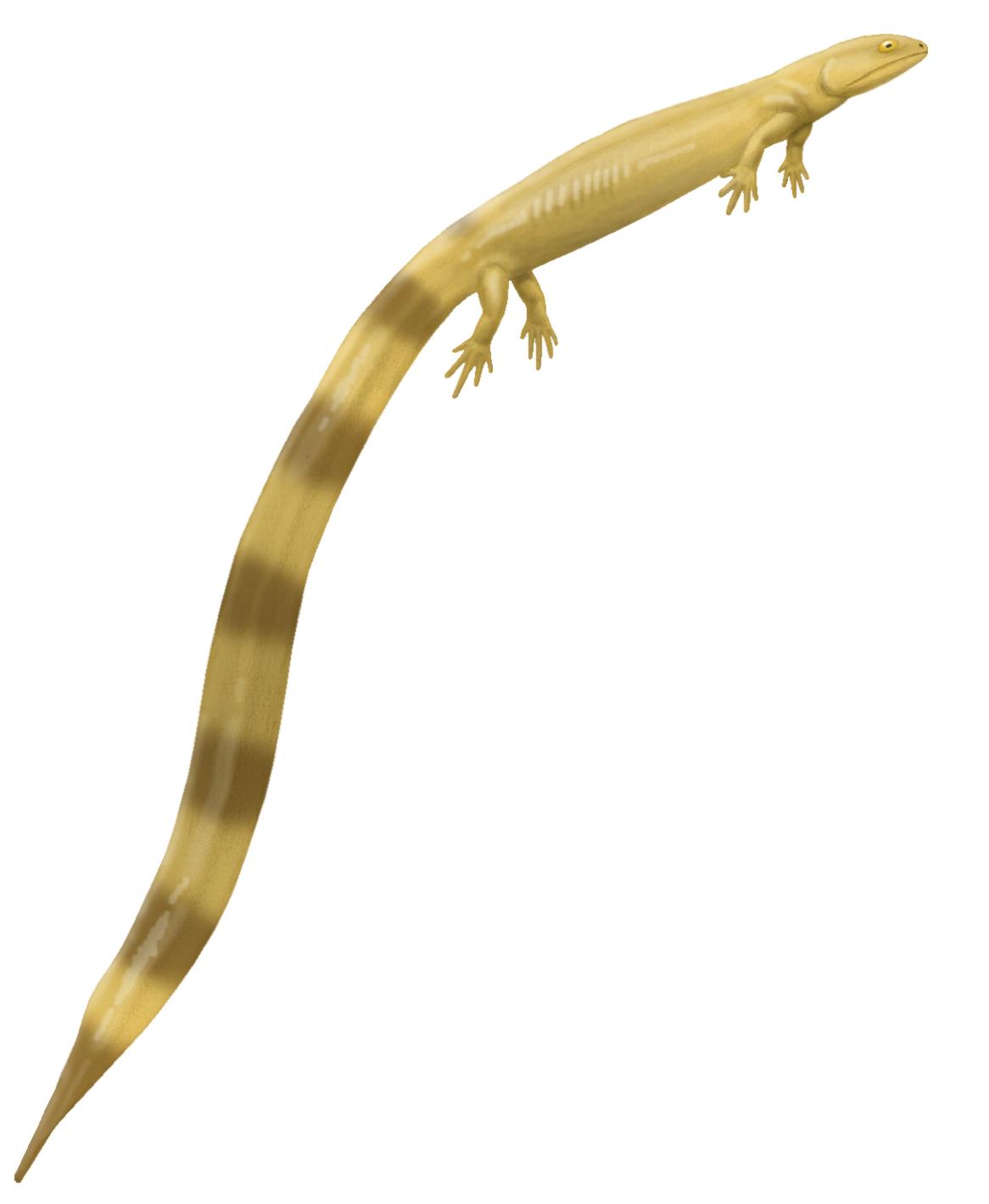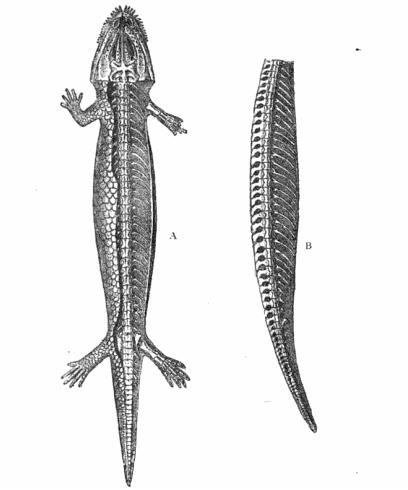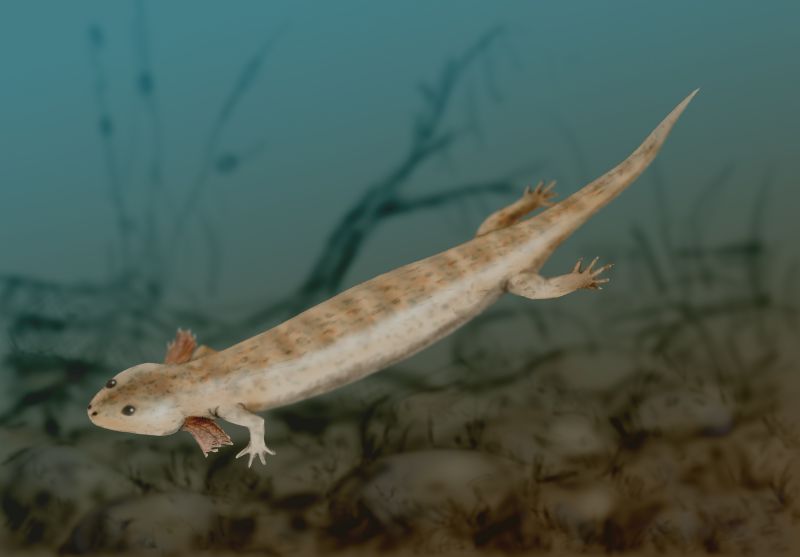|
Utaherpeton
''Utaherpeton'' is an extinct genus of lepospondyl amphibian from the Carboniferous of Utah. It is one of the oldest and possibly one of the most basal ("primitive") known lepospondyls. The genus is monotypic, including only the type species ''Utaherpeton franklini''. ''Utaherpeton'' was named in 1991 from the Manning Canyon Shale Formation, which dates to the Mississippian- Pennsylvanian boundary. It was originally classified within Microsauria, a group of superficially lizard- and salamander-like lepospondyls that is now no longer considered to be a valid clade or evolutionary grouping, but rather an evolutionary grade consisting of the most basal lepospondyls. ''Utaherpeton'' has been proposed as both the most basal lepospondyl and the oldest "microsaur", although more derived lepospondyls are known from earlier in the Carboniferous. However, its position within Lepospondyli remains uncertain due to the incomplete preservation of the only known specimen. The inclusion of ''Ut ... [...More Info...] [...Related Items...] OR: [Wikipedia] [Google] [Baidu] |
Microsauria
Microsauria ("small lizards") is an extinct, possibly polyphyletic order of tetrapods from the late Carboniferous and early Permian periods. It is the most diverse and species-rich group of lepospondyls. Recently, Microsauria has been considered paraphyletic, as several other non-microsaur lepospondyl groups such as Lysorophia seem to be nested in it. Microsauria is now commonly used as a collective term for the grade of lepospondyls that were originally classified as members of Microsauria. The microsaurs all had short tails and small legs, but were otherwise quite varied in form. The group included lizard-like animals that were relatively well-adapted to living on dry land, burrowing forms, and others that, like the modern axolotl, retained their gills into adult life, and so presumably never left the water. Distribution Microsaur remains have been found from Europe and North America in Late Carboniferous and Early Permian localities. Most North American microsaurs have bee ... [...More Info...] [...Related Items...] OR: [Wikipedia] [Google] [Baidu] |
1991 In Paleontology ...
Plants Angiosperms Arthropods Insects Mollusca Newly named bivalves Archosauromorphs * Sankar Chatterjee's discovery of a possible Triassic bird, ''Protoavis'', if genuine, would push avian origins back almost 70 million years. The find ignites controversy over the connection between dinosaurs and birds. Newly named dinosaurs Data courtesy of George Olshevsky's dinosaur genera list. Newly named birds Genera no longer considered to be birds * ''Protoavis''. The avian status of ''Protoavis'' has since been almost universally rejected by paleontologists. Pterosaurs New taxa Synapsids Non-mammalian References {{portal, Paleontology 1990s in paleontology Paleontology Paleontology (), also spelled palaeontology or palæontology, is the scientific study of life that existed prior to, and sometimes including, the start of the Holocene epoch (roughly 11,700 years before present). It includes the study of fossi ... [...More Info...] [...Related Items...] OR: [Wikipedia] [Google] [Baidu] |
Phylogenies
A phylogenetic tree (also phylogeny or evolutionary tree Felsenstein J. (2004). ''Inferring Phylogenies'' Sinauer Associates: Sunderland, MA.) is a branching diagram or a tree showing the evolutionary relationships among various biological species or other entities based upon similarities and differences in their physical or genetic characteristics. All life on Earth is part of a single phylogenetic tree, indicating common ancestry. In a ''rooted'' phylogenetic tree, each node with descendants represents the inferred most recent common ancestor of those descendants, and the edge lengths in some trees may be interpreted as time estimates. Each node is called a taxonomic unit. Internal nodes are generally called hypothetical taxonomic units, as they cannot be directly observed. Trees are useful in fields of biology such as bioinformatics, systematics, and phylogenetics. ''Unrooted'' trees illustrate only the relatedness of the leaf nodes and do not require the ancestral root to be ... [...More Info...] [...Related Items...] OR: [Wikipedia] [Google] [Baidu] |
Carboniferous Amphibians Of North America
The Carboniferous ( ) is a geologic period and system of the Paleozoic that spans 60 million years from the end of the Devonian Period million years ago ( Mya), to the beginning of the Permian Period, million years ago. The name ''Carboniferous'' means "coal-bearing", from the Latin '' carbō'' ("coal") and '' ferō'' ("bear, carry"), and refers to the many coal beds formed globally during that time. The first of the modern 'system' names, it was coined by geologists William Conybeare and William Phillips in 1822, based on a study of the British rock succession. The Carboniferous is often treated in North America as two geological periods, the earlier Mississippian and the later Pennsylvanian. Terrestrial animal life was well established by the Carboniferous Period. Tetrapods (four limbed vertebrates), which had originated from lobe-finned fish during the preceding Devonian, became pentadactylous in and diversified during the Carboniferous, including early amphibian lineages ... [...More Info...] [...Related Items...] OR: [Wikipedia] [Google] [Baidu] |
Carboniferous Amphibians
The Carboniferous ( ) is a geologic period and system of the Paleozoic that spans 60 million years from the end of the Devonian Period million years ago ( Mya), to the beginning of the Permian Period, million years ago. The name ''Carboniferous'' means "coal-bearing", from the Latin '' carbō'' ("coal") and '' ferō'' ("bear, carry"), and refers to the many coal beds formed globally during that time. The first of the modern 'system' names, it was coined by geologists William Conybeare and William Phillips in 1822, based on a study of the British rock succession. The Carboniferous is often treated in North America as two geological periods, the earlier Mississippian and the later Pennsylvanian. Terrestrial animal life was well established by the Carboniferous Period. Tetrapods (four limbed vertebrates), which had originated from lobe-finned fish during the preceding Devonian, became pentadactylous in and diversified during the Carboniferous, including early amphibian line ... [...More Info...] [...Related Items...] OR: [Wikipedia] [Google] [Baidu] |
Monophyletic
In cladistics for a group of organisms, monophyly is the condition of being a clade—that is, a group of taxa composed only of a common ancestor (or more precisely an ancestral population) and all of its lineal descendants. Monophyletic groups are typically characterised by shared derived characteristics ( synapomorphies), which distinguish organisms in the clade from other organisms. An equivalent term is holophyly. The word "mono-phyly" means "one-tribe" in Greek. Monophyly is contrasted with paraphyly and polyphyly as shown in the second diagram. A ''paraphyletic group'' consists of all of the descendants of a common ancestor minus one or more monophyletic groups. A '' polyphyletic group'' is characterized by convergent features or habits of scientific interest (for example, night-active primates, fruit trees, aquatic insects). The features by which a polyphyletic group is differentiated from others are not inherited from a common ancestor. These definitions have tak ... [...More Info...] [...Related Items...] OR: [Wikipedia] [Google] [Baidu] |
Paraphyletic
In taxonomy (general), taxonomy, a group is paraphyletic if it consists of the group's most recent common ancestor, last common ancestor and most of its descendants, excluding a few Monophyly, monophyletic subgroups. The group is said to be paraphyletic ''with respect to'' the excluded subgroups. In contrast, a monophyletic group (a clade) includes a common ancestor and ''all'' of its descendants. The terms are commonly used in phylogenetics (a subfield of biology) and in the tree model of historical linguistics. Paraphyletic groups are identified by a combination of Synapomorphy and apomorphy, synapomorphies and symplesiomorphy, symplesiomorphies. If many subgroups are missing from the named group, it is said to be polyparaphyletic. The term was coined by Willi Hennig to apply to well-known taxa like Reptilia (reptiles) which, as commonly named and traditionally defined, is paraphyletic with respect to mammals and birds. Reptilia contains the last common ancestor of reptiles a ... [...More Info...] [...Related Items...] OR: [Wikipedia] [Google] [Baidu] |
Aïstopod
Aistopoda (Greek for " avingnot-visible feet") is an order of highly specialised snake-like stegocephalians known from the Carboniferous and Early Permian of Europe and North America, ranging from tiny forms only , to nearly in length. They first appear in the fossil record in the Mississippian period and continue through to the Early Permian. The skull is small but very specialised, with large orbits, and large fenestrae. The primitive form ''Ophiderpeton'' has a pattern of dermal bones in the skull similar in respects to the temnospondyls. But in the advanced genus ''Phlegethontia'' the skull is very light and open, reduced to a series of struts supporting the braincase against the lower jaw, just as in snakes, and it is possible that the aistopods filled the same ecological niches in the Paleozoic that snakes do today. They had an extremely elongated body, with up to 230 vertebrae. The vertebrae were holospondylous, having only a single ossification per segment. They lac ... [...More Info...] [...Related Items...] OR: [Wikipedia] [Google] [Baidu] |
Nectridea
Nectridea is the name of an extinct order of lepospondyl tetrapods from the Carboniferous and Permian periods, including animals such as ''Diplocaulus''. In appearance, they would have resembled modern newts or aquatic salamanders, although they are not close relatives of modern amphibians. They were characterized by long, flattened tails to aid in swimming, as well as numerous features of the vertebrae. Description Nectrideans are a diverse group of tetrapods, including the aquatic Urocordylidae, the presumably terrestrial Scincosauridae, and the bizarre horned members of Diplocaulidae (also known as Keraterpetonidae), which includes the "boomerang-headed" ''Diplocaulus'', one of the most famous genera of prehistoric amphibians (in the traditional sense of the word). By the time the earliest known nectrideans appeared in the Late Carboniferous fossil record, they had already diversified into these families, indicating that basal nectrideans are unknown. These different famili ... [...More Info...] [...Related Items...] OR: [Wikipedia] [Google] [Baidu] |
Hyloplesion
''Hyloplesion'' is an extinct genus of microbrachomorph microsaur. It is the type and only genus within the family Hyloplesiontidae. Fossils have been found from the Czech Republic near the towns of Plzeň, Nýřany, and Třemošná, and date back to the Middle Pennsylvanian. The type species is ''H. longicostatum'', named in 1883. Two species belonging to different genera, ''Seeleya pusilla'' and ''Orthocosta microscopica'', have been synonymized with ''H. longicostatum'' and are thought to represent very immature individuals. Description ''Hyloplesion'' was about as large as a medium-sized salamander, with the length of known specimens ranging from 17-77mm. The skull is triangular in shape. Unlike many other microsaurs, the palate of ''Hyloplesion'' contains large vacuities, or openings. The fifth maxillary tooth is enlarged and resembles a canine. The skull of ''Hyloplesion'' superficially resembles that of the unrelated romeriid reptile ''Romeria'' in lateral view d ... [...More Info...] [...Related Items...] OR: [Wikipedia] [Google] [Baidu] |
Microbrachis
''Microbrachis'' is an extinct genus of lepospondyl amphibian from the Carboniferous Kladno Formation of the Czech Republic. Description ''Microbrachis'' was an elongated, salamander-like creature, about long, with over 40 vertebrae instead of the average 15–26 in its living relatives. It had minute limbs, and probably swam using fish-like lateral body movements. ''Microbrachis'' probably fed on fresh water plankton such as shrimp. ''Microbrachis'' was pedomorphic, retaining its larval gills in adulthood. Similar traits are found in the extant axolotl The axolotl (; from nci, āxōlōtl ), ''Ambystoma mexicanum'', is a paedomorphic salamander closely related to the tiger salamander. Axolotls are unusual among amphibians in that they reach adulthood without undergoing metamorphosis. I .... References Further reading * Andrew R. Milner, "The Tetrapod Assemblage from Nýrany, Czechoslovakia", in Systematics Association Special Volume No.15, "The Terrest ... [...More Info...] [...Related Items...] OR: [Wikipedia] [Google] [Baidu] |







